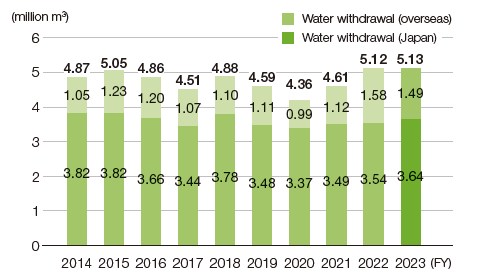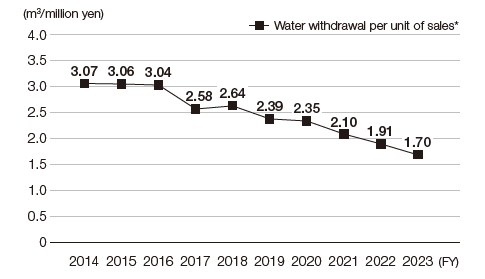Conserving Water Resources
The OECD's 2012 report entitled Environmental Outlook to 2050 states that during the period between 2000 and 2050, global demand for water will increase by approximately 55% owing to economic development and population increase, while more than 40% of the world's population will be living in river basins that suffer from severe water shortages.
The Kubota Group sees conserving water resources as one of its materiality issues, and has been advancing initiatives to promote the effective utilization of water resources and to address water risks, such as the reduction of water consumption by promoting water saving and wastewater recycling, and the proper management of wastewater treatment and wastewater quality. Production sites promote measures not to cause adverse effects on local ecosystems and the lives of local residents, taking into consideration the status of water stress in the respective regions.
- Activities towards achieving SDGs
- Medium-Term Environmental Conservation Targets and the Results for FY
- Conserving Water Resources
- Controlling Water Discharge and Mitigating Water Risks
Activities towards achieving SDGs
| Related SDGs and targets |
 |
|---|---|
| Major Activity Content |
|
| 2025 Activity Targets (KPIs) |
|
Medium-Term Environmental Conservation Targets and the Results for FY
| Action item | Management indicator*1 | Base FY | Target for FY2025*2 | Target for FY2030*2 |
FY2023 Result |
|---|---|---|---|---|---|
| Conserve water resources | Water withdrawal per unit of production | 2014 | ▲35% | ▲40% | ▲36.5% |
- *1.The figures per unit of production represent the intensity of the environmental load per unit of money amount of production. The exchange rate of the base year is used when translating the money amount of production of overseas sites into Japanese yen.
- *2.▲ indicates a negative figure.
Conserving Water Resources
1. Water Withdrawal
In FY2023, water withdrawal was 5.13 million m3, an increase of 0.1% compared to the previous year. On the other hand, water withdrawal per unit of sales improved by 11.2% compared to the previous year. Although water usage at casting production sites increased, overall water usage was about the same as in the previous year due to the installation of water recycling equipment in India. Water withdrawal per unit of sales improved as consolidated net sales increased (up 12.8% from the previous year).
-
Trends in Total Water Withdrawal and Withdrawal per Unit of Sales
- Water withdrawal per unit of consolidated net sales. The Kubota Group adopted International Financial Reporting Standards (IFRS) instead of accounting principles generally accepted in the United States of America from FY2018.
2. Measures to Reduce Water Withdrawal
The Kubota Group has established the Medium-Term Environmental Conservation Targets and is working to reduce water withdrawal at production sites. Our production sites, such as those in China, Thailand, Indonesia and the United States, have introduced wastewater treatment facilities or wastewater recycling systems utilizing technologies of the Kubota Group.
In FY2023, in addition to installing water-saving faucets and toilets and carrying out routine activities such as patrols to check for water leaks, the Kubota Group continued to improve its methods for watering green areas. We also reduced water withdrawal in the production process mainly by thoroughly managing the extraction of well water in proportion to production volume and by replacing water-cooled compressors with air-cooled ones. As a result of the efforts toward achieving the Medium-Term Environmental Conservation Targets 2025 for water withdrawal reduction, global production sites achieved a reduction of approximately 49,000 m3 in FY2023 compared to the case where countermeasures were not implemented from the previous year. The economic effects of these measures reached 17 million yen compared to the previous year. Water withdrawal per unit of production in FY2023 improved by 36.5% compared to the base year (FY2014).
We will continue to promote the reduction of water withdrawal through initiatives to promote the 3Rs of water, such as conducting water- saving activities and promoting water recycling by using the Kubota Group’s technologies.
-

Kubota Engine (Thailand) Co., Ltd. has added additional capacity to its wastewater treatment system with the use of a membrane bioreactor (MBR). Recycled water is being used to water the gardens around the plant and as domestic water.
-
Water Withdrawal by Region
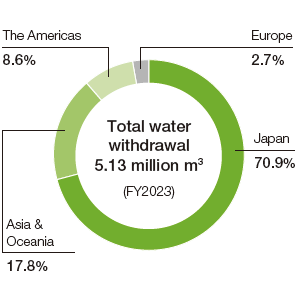
-
Water Withdrawal by Business

-
Water Withdrawal by Type
-
Japan
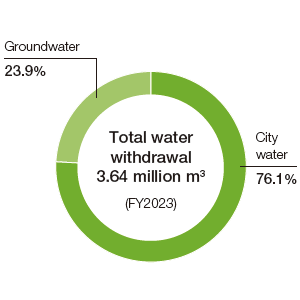
-
Overseas
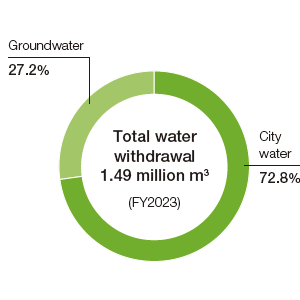
-
Please follow the link below for water withdrawal amounts at each production site. https://www.kubota.com/sustainability/environment/report/2024/sitereport.html
3. Water Management
The Kubota Group is committed to understanding, managing, and conserving water use at all of its 199 companies. Every year, our production sites draw up and revise a management plan for reducing the amount of water withdrawal, based on the Group’s Medium-Term Environmental Conservation Targets. Measures are also being taken at all 72 production sites to thoroughly manage water quality and prevent environmental accidents.
[Summary of water management in environment-related rules and regulations]
- An environmental management system shall be established at all sites to systematically promote environmental conservation activities.
- A monitoring system for environmental conservation shall be developed at all sites so as to periodically carry out examinations and inspections.
- The amount of water (service water, industrial water, groundwater, and recycled water) used and discharged at all sites in the course of business activities shall be assessed.
- Efforts shall be made to reduce the amount of water resources used at all sites. Also, a plan to reduce water withdrawal at all production sites shall be formulated, tracked, and revised every year.
- Water quality-related equipment shall be thoroughly managed (ensuring water treatment capacity, complying with design/ management standards, maintenance/operation) at all production sites, while environmental pollution risks associated with such equipment shall be mitigated and environmental accidents prevented from occurring.
Controlling Water Discharge and Mitigating Water Risks
The Kubota Group has set its own control values that are stricter than the emission standards of relevant laws and regulations. To ensure that the standard values are not exceeded, the Kubota Group carries out regular measurement of designated monitoring items. Under the Medium-Term Environmental Conservation Targets 2025, the Group has established a new target of managing water discharge appropriately in line with standards for the areas where wastewater is released by operating wastewater treatment and water recycling facilities. The amount of water discharge* in FY2023 was 5.25 million m3 (0.98 million m3 into surface water, 2.12 million m3 into seawater/ocean, and 2.15 million m3 into sewage) , an increase of 4.9% from the previous year. At each site, we promote the reduction of water withdrawal by taking measures to reduce the amount of water discharge. We will continue to reduce the load on the local water environment through activities to manage water discharge and reduce water withdrawal.
- The amount of wastewater discharge includes rain and spring water at some business sites.
-

Kubota Sakai Rinkai Plant (Japan)
Submerged-type FRP johkasou, decentralized Submergedtype FRP joh
